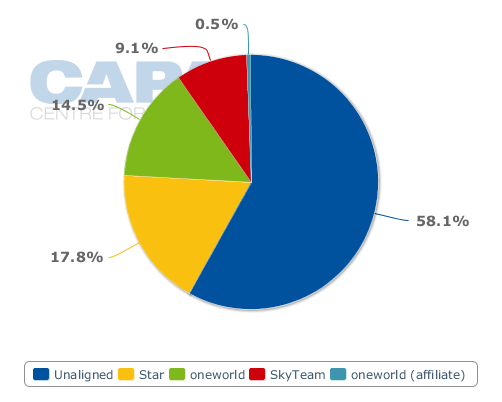Aeromexico continues to build partnerships outside SkyTeam
Aeromexico's new codeshare agreement with Brazilian carrier TAM represents the second agreement Mexico's largest carrier has signed with a non-SkyTeam carrier in the last two months. The partnerships reflect the need for both Star and SkyTeam carriers to access key markets in Latin and Central America that are not available through their respective alliance partners.
The Avianca-TACA relationship with Aeromexico, announced in Mar-2012, was surprising given that the Kriete family, which is a main shareholder in Avianca-TACA, is also a major holder in Aeromexico's competitor Volaris. But Aeromexico has been pursuing a tie-up with Colombia's largest carrier, Avianca, since it started Mexico City-Bogota flights in 2010. The chance was brushed aside once Avianca-TACA opted to join the Star Alliance, but now the agreement will include more connections than just Bogota as Avianca-TACA cited an ability to partner with Aeromexico on flights to Central and South America during the second half of this year.
By partnering with Avianca, Aeromexico gains stronger feed behind its 18 weekly flights to Bogota at a time when Colombia's GDP is estimated to grow at a 4.5% rate in 2012.
Aeromexico serves the major Latin American destinations of Bogota, Buenos Aires, Lima, Santiago and Sao Paulo, so forging partnerships with carriers having vast networks in those countries is crucial to boosting its revenue in its South American markets. Aeromexico already has a codeshare with LAN, which is in the midst of merging with TAM to become the largest carrier in South America. Partnering with those carriers gives Aeromexico strategic feed behind Aeromexico's flights from Mexico City to Sao Paulo, Santiago and Lima. Aerolineas Argentina is in the process of joining SkyTeam, which will eventually provide feed into Aeromexico's Buenos Aires-Mexico City route.
Conversely Aeromexico's partners get access to the vast Aeromexico domestic network in Mexico including Acapulco, León, Ciudad Obregón, Cancún, Guadalajara, Monterrey, Poza Rica, Los Cabos and Veracruz. Codeshare passengers from Latin America will likely have better connections through Mexico City as Aeromexico plans to increase its daily departures from the airport this year to 500-530 from an average of 442 in 2011. Access to the Mexican market is growing in importance as Mexico's GDP is set to rebound to 3.7% growth in 2013. This year the country's GDP is expected to grow 3.5%, which is less than the 3.8% growth recorded in 2011.
See related article: Fuel costs create uncertainty for continued profitability of Latin American carriers
Aeromexico's decision to codeshare with TAM presents another interesting twist in the evolving partnership landscape in Latin America. Delta Air Lines last year took stakes in both Aeromexico and Brazil's second largest carrier Gol.
See related articles:
- Delta to acquire stake in Aeromexico as part of expanded alliance
- Delta's investment in Gol has SkyTeam and broader US-LatAm strategic implications
But despite growing closer to SkyTeam through the Delta investment and a pledge to codeshare with Aerolineas, Gol has repeatedly stated publicly that it intends to remain unaligned with any of the global alliance groupings. Gol with its largely domestic focus does not operate flights to Mexico, which would make a deal less attractive to Aeromexico since there would be no connecting traffic for Aeromexico's domestic network from its Mexico City hub. TAM in announcing the deal with Aeromexico highlighted access for Brazilian passengers to Aeromexico's roughly 40 domestic destinations.
TAM is also expected to jump to the oneworld alliance from Star once the merger with LAN is complete. With Aeromexico's existing relationship with LAN, it likely made more sense for Aeromexico to partner with TAM to expand the partnership to the combined LATAM's prolific South American network. TAM will potentially bolster oneworld's strategic presence in Latin America significantly.
See related article: oneworld favoured with more at stake than Star in LAN-TAM alliance decision
Latin America capacity share by alliance (seats per week): 16-Apr-2012 to 22-Apr-2012
The interesting twists in Latin American tie-ups will likely continue as traffic growth in the region dictates that carriers serving those countries have access to key markets, even if that means jumping outside their respective alliances to ensure they capture their share of traffic growth.
